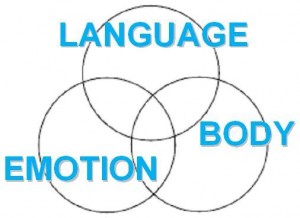In a recent coaching teleclass a participant asked, “is it our mood that creates our language, or is it the words and stories we use that create our mood?” She was looking for a neat and crisp definition of how people work.
It ain’t that simple. Figuring out how people work is like solving the Chicken or Egg puzzle – which came first?
The answer to the above question is not either/or; it’s Yes. Both.

The mood or emotion we’re in affects our behavior and it influences what we say and what we think. Our thoughts/language lead to the emotion we’re in and also affect our behavior. And of course our behavior leads to consequences that subsequently influence our reactions and stories.
A recent comic strip illustrated this principle beautifully. It’s called Non Sequitur (distributedby Universal Press Syndicate). Some context is important. The main character, Danae, is a very wise 10-year old girl who wears a black T-shirt emblazoned with a skull, and she is always in a foul mood, believing that everything wrong in the world is the fault of a conspiracy spawned by “booger-brained boys.”
- Frame 1: Danae stands with a smile on her face and thinks: “I’m in a good mood today… I wonder why?”
- Frame 2: “Hmmph… oh, well” she says out loud, and she skips merrily down the street, passing Timmy, a boy who lives nearby. He turns around and says, “Geez, why’re you in such a foul mood?”
- Frame 3: Startled, Danae asks, “what?” “you said ‘hmmph’…” “So?” “It sounds cranky” “does not” “If you say so…”
- Frame 4: “Hey, I was in a GOOD mood!” “Ahh.. ‘was’… past tense…” he says, turning away. “No… I AM IN A GOOD MOOD!!” “Then why are you shouting??”
- Frame 5: “’CUZ NOW I’M IN A BAD MOOD!” she screams, black smoke and a death’s head emerging from her mouth. And as Timmy walks away he says, “Hmmph… Well, I was in a great mood ‘til you came along”
I love this strip, although I’m sure the illustrator was not thinking of modeling ontological principles when he wrote it. He demonstrates first how the mood affects thinking and behavior; then how different language changes the mood and then the behavior – of both parties!
Who we are and how we show up is a constant dance and balancing act between what we think, the emotion we’re in, and what we do. To live a happy life we must monitor ourselves in all three areas and recognize that even minor shifts in one can transform the other.
Some examples:
- Shifting our “story” about other people’s motives can cause us to move from suspicion to trust to calm to worry… and how we react to those people will vary based on the mood we put ourselves in.
- Taking a few deep breaths can calm both our emotions and our thinking.
- Moving fast and getting caught up in being busy-busy-busy can shift our mood to anxiety and focuses our thinking on what’s NOT done versus what we have accomplished.
- If we are “feeling good” and run in to another person who’s having a bad day, we can hold fast to our own mood by carefully monitoring our language to avoid picking up the conversation that other person wants to pull us into.
- Wearing a smile pulls our emotions up and opens our thinking
So, the answer to Which? is Yes. If we want to live a balanced life, then, we must attend to all three areas: the stories we tell ourselves and others, the emotions we’re feeling, and how we interact with others.
Have a happy one; and remember that YOU are in charge of how you experience life today!

1 thought on “Mood and Language: which comes first?”